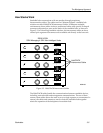
Stackables 3-7
The Workgroup Approach
Initially, Network Designers wishing to make connections from stacks to
backbone technologies would be forced to add an additional standalone device to
the network at the workgroup area. The addition of a standalone switch, bridge,
or router that supported the technology of the stack and the technology of the
backbone would allow for the interconnection, or internetworking, of the stack
and the backbone.
To assist Network Designers in creating a flexible and elegant solution to the
problem of internetworking for stacks, and to reduce the number of separate
devices that had to be shepherded at any facility, Cabletron Systems introduced
Bridge/Router Interface Module (BRIM) technology to the stackable and
standalone product line.
The BRIM is a specialized module that can be added to any BRIM-capable
Cabletron Systems device. The BRIM provides two interfaces: one to the internal
network segment of the device that it is placed in, and one to an external network.
Several BRIMs are available to support a wide variety of networking
technologies. The available BRIMs and their configuration options are detailed in
Chapter 4, PIMs and BRIMs.
By incorporating the BRIM technology into a number of standalone and stackable
devices, Cabletron Systems makes it easy to use stackable hubs and standalone
switches as frontier devices for an enterprise network, or as a small workgroup
solution at any location. The availability of Wide Area Network (WAN)
technology BRIMs also makes the BRIM-capable stackable devices ideal choices
for branch office scenarios.
Limitations of Stacks
While stackables are very well suited to a number of network implementations,
they have their limitations. As stackables were developed to fill the gap between
standalone devices and modular chassis, some networking capabilities are better
handled by modular hubs.
Modular chassis allow for the mixing of multiple technologies in a single location
much more readily than stackables. If a network implementation requires 43
Ethernet users, 11 Token Ring users, and four FDDI stations, a single modular
chassis will support these requirements, while a series of stackable and
standalone devices would have to be purchased, installed, and maintained to
accommodate the same need.


















